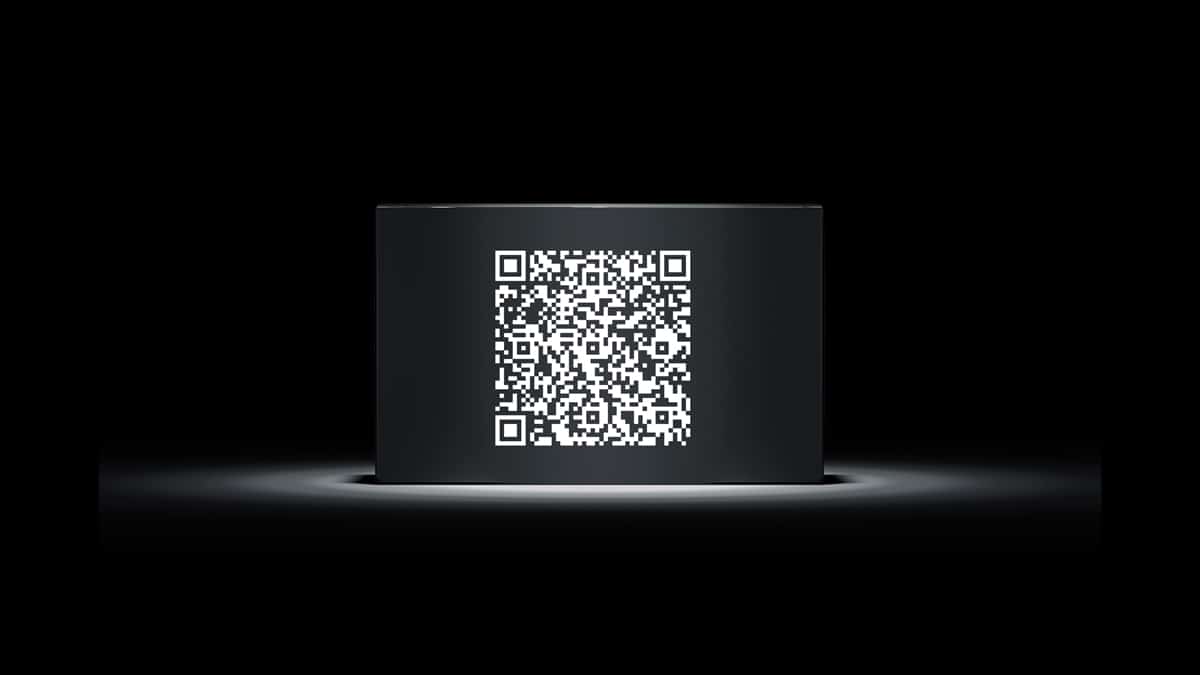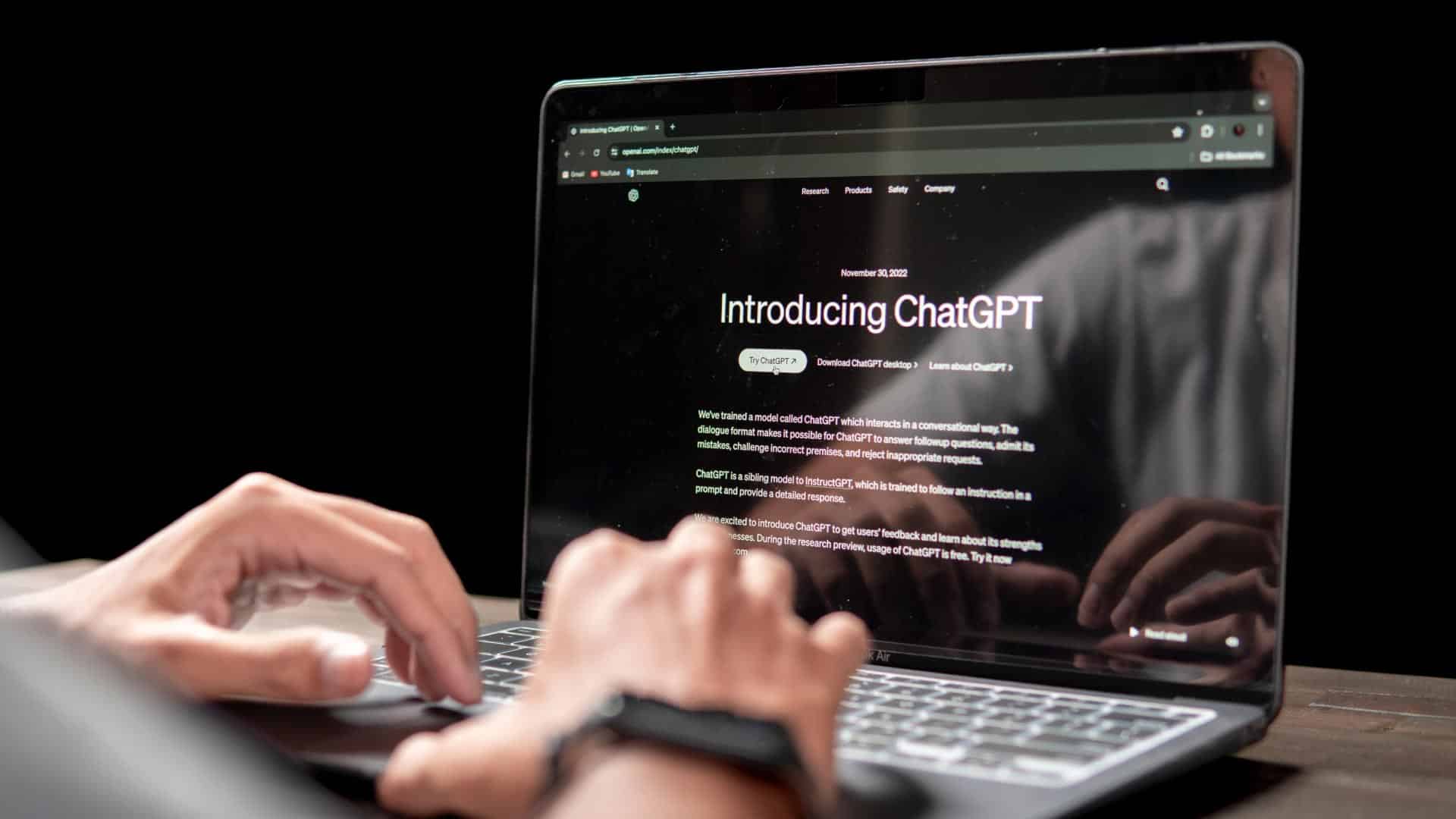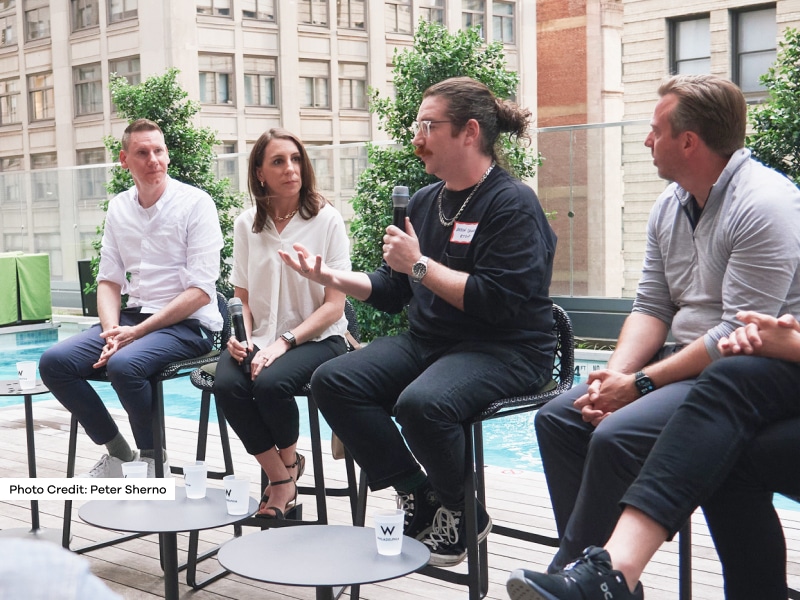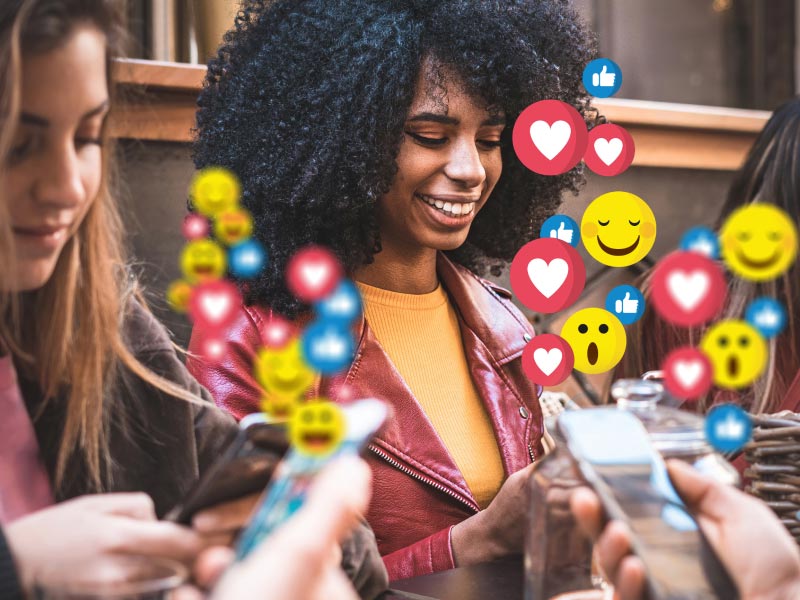At Mod Op, our years of experience in the agricultural sector have given us a keen appreciation for the resilience of America’s farmers. It’s just in their DNA. But today, farmers, ranchers and dairy producers are grappling with a bushel of challenges, including drought and water availability, high input costs and profit pressure, regulatory and environmental challenges, labor shortages, trade uncertainty, and general market volatility.
As if that weren’t enough, farmers are constantly bombarded by content, messaging and advertising. For National Ag Day, we wanted to look at ways for brands to effectively reach farmers, and what they need to understand about the demands facing agriculture as well as the opportunities they offer.
Challenges Facing Farmers
First of all, there’s the weather. Our key agricultural regions, including the Great Plains, California, and the Southwest, continue to face ongoing drought conditions and water restrictions that negatively impact production.
Rising input costs for fertilizer, fuel, seed, and crop protection products also cut into profit margins. Livestock producers are feeling the pinch, too, thanks to high feed costs. And as interest rates have climbed, it’s more expensive to finance equipment, land and operating loans.
Regulatory and environmental pressures around pesticide use, fertilizer application, and emission are also impacting farmers. Carbon credit programs and sustainability initiatives present challenges and opportunities for producers while WOTUS (Waters of the U.S.) and similar policies create uncertainty.
Then there’s the shrinking, aging labor pool, especially for seasonal and skilled farm workers, that drives up wages and reduces operational efficiency. H-2A visa program complexities and uncertainty around immigration policies are constricting the availability of farm labor.
Next to weather, timing is everything in ag marketing
Marketers wanting to reach farmers need to appreciate the cyclical nature of their business, as well as its complexity and sophistication. Fluctuations in grain and livestock prices require daily monitoring and make long-term planning difficult. Trade disputes, export restrictions, and shifting consumer demand also impact exports, especially in Canada, Mexico, and China.
When prices drop, farmers will scale back on spending, but when commodity prices are high, they’re more likely to reinvest in equipment, technology, land, and labor.
From an equipment and technology standpoint, innovative solutions are constantly being developed and brought to the market to help farmers improve the efficiency and profitability of their operations, while protecting their business for future generations.
Opportunities for Brands
Unprecedented growth has lured a new generation of entrepreneurs and investors who are offering innovative solutions to help farmers, ranchers and dairy producers become more profitable.
Ag-tech startups have flocked to agriculture with solutions that help producers overcome water use restrictions with drought-tolerant crops and precision irrigation systems, for example.
But the most fruitful opportunity for innovation may lie in farm data. Not wanting to be left out, mature tech companies like Microsoft and Amazon are muscling into the ag-tech space, helping farmers turn the volumes of information they collect into actionable insights. Microsoft’s Azure Data Manager for Agriculture is just one example; it provides industry-specific capabilities to connect farm data, enabling organizations to use high-quality datasets and develop solutions that power agriculture insights.
The integration of advanced technologies including artificial intelligence (AI), machine learning, the Internet of Things (IoT), robotics, and data analytics makes it possible for ag-tech startups to thrive while giving investors incredible opportunities. These technologies enable solutions that address critical challenges in farming, including labor, food production efficiency, sustainability, and resource management. Tech companies and brands focused on solving these problems are positioned to drive substantial changes in the ways farmers and ranchers operate.
Farmers’ Changing Media Habits
To keep pace with the changes and challenges they face, farmers have altered their media consumption habits. Like everyone, they’ve increasingly integrated more digital platforms into their daily routines. This shift reflects a broader trend toward technology adoption in agriculture, influencing how farmers access information, engage with communities, and market their products.
Social Media’s Popularity
Brands wanting to reach today’s farmers, ranchers and dairy producers have more platforms and media outlets than ever.
Farmers are on major social media platforms to share their experiences, educate the public and connect with peers. YouTube, Facebook, TikTok and Instagram are popular for highlighting daily farming activities and fostering community engagement.
While they may still regularly visit the coffee shop to talk politics and markets, the adoption of smartphones and tablets among farmers offers them instant access to information and digital tools. Most can put autonomous farm equipment in motion, sell grain or livestock, buy land, or purchase farm equipment and supplies from apps on their mobile phone or tablets. They view weather forecasts, get soil sample results, read market commentary, and keep up with current events from these same devices. Access to information for them to make their business decisions has never been more plentiful, but it has evolved.
Video is Preferred
Video content has become the preferred medium for farmers seeking information and entertainment. A 2022 study by Successful Farming revealed 90% of farmers watch short online videos, including news, sports highlights, how-to guides and product reviews.
Audio content, including podcasts and other streaming programs, has also seen increased adoption among farmers of all ages. Some things, however, have remained the same. Take farm radio for example. Farm broadcasters remain one of the most trusted go-to resources for local farm news, weather, and markets.
Cultivate by Mod Op
Mod Op’s commitment to agriculture runs deep. We’ve collaborated with notable companies like John Deere, Nutrien, Earth Optics, Phospholutions, PBI Gordon, Rosen’s, Norbrook, Agrievolution, and Adams Land and Cattle. In response to the increased sophistication of farming and the evolving trade media landscape in the sector, we’ve launched Cultivate by Mod Op, a specialized division offering comprehensive digital marketing solutions tailored for the business of agriculture. Cultivate enables agricultural companies and brands to access a fully integrated suite of marketing services essential for success in today’s market, including building brand identity, developing product packaging, launching innovative campaigns, and engaging key stakeholders effectively.
As agriculture has become increasingly tech-forward, Mod Op is merging innovative digital tools with deep industry expertise to help agriculture companies harness innovation and maintain competitiveness. From data and AI-powered strategy recommendations to creative storytelling, Cultivate helps clients navigate the complexities of the digital environment and highlight technology leadership.
As Mod Op CEO Eric Bertrand explains, Cultivate represents a strategic move by Mod Op that reflects a broader trend in agricultural trade media. Agencies are adapting to meet the industry’s demand for data insights and sophisticated digital marketing strategies. By offering tailored solutions through Cultivate, Mod Op is positioning itself as a leader in this rapidly evolving sector, helping clients adapt and thrive against a complex landscape that is ripe for innovation.
The Latest
We study the game as hard as we play it.
Learn with us what’s now and next.
Marketing is a balancing act. Lean too far into authenticity and relevance, and you might create content that wins hearts but not conversions. Focus too much on key performance indicators (KPIs), and you risk churning out robotic, sales-first messaging that alienates your audience. The magic happens when you find that sweet spot – where your brand feels real, resonates with your audience, and still meets business objectives.
Here’s the challenge: the marketing funnel isn’t linear, guiding consumers straight from awareness to conversion. People zigzag, loop back, and sometimes drop off completely. This means your content and ad placement strategy need to be in sync, ready for all the twists and turns along the way.
If you create an emotionally compelling video but place it in an ad slot that is getting an average viewership of 4 seconds, your masterpiece won’t get the standing ovation it deserves. It would be like dropping a Taylor Swift album on a random Tuesday without a single Easter egg teaser; your audience just isn’t primed for it. Instead, you have to meet your audience where they are, in a format they’ll engage with, and in a way that makes sense for your business goals. And the way to find out what that is: data.
If you’re thinking, “sounds great in theory, but how do I actually make that happen?” I’m so glad you asked! Taking it from the top, media and creative should not live in silos. As with so much in marketing, a collaborative approach is going to put you in the best starting position.
Once programs are live, this is where the fun really begins. Testing isn’t a one-and-done activity; it’s a continuous process of trial, error, and adaptation. What works on Instagram Reels might flop on TikTok, despite the ad placements having nearly identical specs. Or a clever, quirky tone could land perfectly with one demographic but feel off-putting to another. By analyzing performance data and paying close attention to what actually resonates, you can refine your approach and build trust over time.
And you don’t have to wait till the next campaign to apply what you learn. In the world of digital marketing, there are many dials that you can turn in real time: this content’s crushing it for a particular audience in this placement – let’s put more dollars behind it. Another piece of content is generating lower-funnel activity in an awareness campaign – let’s see what it can do in retargeting programs. This top performing piece of content is finally starting to hit creative fatigue – let’s try to refresh.
At the end of the day, authenticity and placement strategy should go hand-in-hand. The best brands know how to be both relatable and results-driven and will use data as a means of getting there. What we know today will always be more than we knew yesterday; an active, fluid approach will make the biggest impact. When you align storytelling with placement strategy, and relevance with real metrics, you create marketing that feels good and delivers. And that’s a KPI worth celebrating.
The Latest
We study the game as hard as we play it.
Learn with us what’s now and next.
Related Stories
It takes less than a minute for Midjourney to generate and spit out an image. But is an image generated with AI as “creative” as one made by a skilled graphic designer? Does it matter? What do apps like Midjourney mean for the future of art and design?
In this AI app-focused blog series, we’re looking at the synergy between AI and human creativity, focusing on how generative AI tools can fuel and enhance creative processes — rather than replace them.
Next up in our AI tools series: Midjourney.
Our reviews are made possible by Mod Op’s AI Playground — an initiative designed to fast-track innovation by allowing team members to experiment with new AI tools quickly and responsibly. When a Mod Op-er finds a promising app, they can submit it. If the application passes our rigorous AI risk and compliance framework, the IT team will assist in setting up a 90-day evaluation period, during which users provide insights on the app’s value. If the application doesn’t pass our risk and compliance framework, we may choose to still move forward with testing, using the vetting framework to create very specific responsible use guardrails. (Spoiler alert: Midjourney did not our team’s risk and compliance framework pass, more on that in a bit.)
What is Midjourney?
Midjourney is an AI tool that generates images from text descriptions. According to ChatGPT, Midjourney “works similarly to other AI-driven image generation models like DALL·E (by OpenAI) and Stable Diffusion. Users can input descriptive prompts, and Midjourney will interpret those prompts to create highly detailed and often visually stunning images.”
Other AI image generation tools include Craiyon, Adobe Firefly, Lenardo.Ai and Bing Image Creator.
How Creatives Can Use Midjourney: Q&A with Aaron Grando
I connected with Aaron Grando, the Technology Director for our award-winning creative team, to learn more about how the team is using Midjourney and where he sees opportunities for the future.
Would you mind sharing a little about how the team is using Midjourney?
First off, it’s important to note that for many projects and brands, AI-generated images from Midjourney are not appropriate to use, for several reasons.
Most importantly, we prioritize good judgement and respect for a client’s product and audience. Take entertainment brands and properties – to the artists that work on them and those that enjoy them – the (conscious or subconscious) value assigned to intellectual property is based on the human point of view, creativity, technique and effort required to produce the final work. So, as marketers, we respect what audiences value about these properties. And it’s clear right now that many audiences are not keen on AI-generated artwork being in the marketing toolkits for many of these brands.
But we have a lot of clients, and many are interested more in speed to market and the impact of the creative. Some even ask us, “Can’t you just AI that?” in cases where we might traditionally spend hours Photoshopping artwork together. For those clients, we’re happy to say “yes – we can.”
This is where our AI Responsible Use Policy kicks in. It helps us understand the outer edges of the creative sandbox where we play but gives us room to experiment and push boundaries. In practice, this means that for a lot of photo and video production, we’re doing some pre-vis work with Midjourney-generated images. Those images are generally not made public, but they help us put together sets, props, costumes, and more as we’re working on creating content that is ultimately released. We’re also increasingly finding use for Midjourney assets in a similar way to how we’ve used stock photography in the past. Which is to say, almost never wholly using stock images, but rather elements from those generated images combined with other visuals – sometimes photographed stock, brand assets, or other AI-generated images – to create final compositions.
Responsible use is so important. Beyond the reasons you’ve already shared, are there other reasons the team tends to reserve Midjourney for pre-production work?
Pre-pro represents the majority of our Midjourney usage at this point, for the reasons mentioned above, but also for simple practical reasons. Midjourney isn’t built into the tools we use day to day, it lives (primarily) in Discord, an app that is still a bit foreign to many creatives.
The images Midjourney generates can be amazing, but they still tend to “feel” AI-generated, which is not an impression we want to give with our work. And, at the moment, Midjourney isn’t great at reproducing images of consumer products in a way that works for marketing, where using accurate depictions are important for consumer trust.
What are your top reasons for using Midjourney?
Midjourney gives teams ways to imagine very specific concepts in mostly polished, highly believable visualizations. In our testing, it produces more aesthetically pleasing images than most, if not all, of its competitors. And dare I say, it’s fun to spin the image generator roulette wheel and see what you get.
What, if anything, can you share about Midjourney and how it impacts speed and turnaround time?
That “roulette wheel” effect is real – it’s still a gamble that usable imagery can be generated more quickly than simply using traditional tools like Photoshop to comp together usable artwork. When it works, it can produce great-looking photo and art assets very quickly. When it doesn’t work, you may burn an hour or longer generating image after image, chasing the perfect iteration, but wind up with nothing that perfectly hits the mark. It’s a concern with all AI-generated content.
How do you expect creatives to leverage AI art generation tools, like Midjourney, in the future?
Short term, I’m looking forward to more integration with traditional design tools, like Figma and Photoshop – I expect that Midjourney at some point will move in that direction. Right now, the copy-and-paste workflow that it demands represents a lot of unnecessary friction.
Medium term, model-agnostic LoRAs or embeddings – chunks of data that tells an AI image generator how to perfectly generate an image of a specific person, place or thing – will start to show up among the assets exchanged between clients and agencies, similar to how 3D objects and high-resolution product photography are currently exchanged. These will let creatives generate images that convincingly integrate client goods directly into the scene, as opposed to needing to ‘shop them into place after generation.
Longer term, I expect that the ability to direct scenes in Midjourney will increase and expand beyond text prompting and region editing (which lets you regenerate sections of generated images). Midjourney has already previewed 3D environments using its technology, so it’s not a stretch to imagine that generated 3D scenes could fed back into the machine to allow creatives to control camera positioning, object placement, lighting, visual effects, and more.
A Word of Caution about Midjourney
While the team’s exploration of Midjourney was made possible by our AI Playground, it’s important to note that the app did not ultimately fall within our risk and compliance framework.
To better understand why, I reached out to Patty Parobek, Mod Op’s VP, AI Transformation, who explained the many reasons that Midjourney didn’t pass our tests:
- Lack of assurances that inputs are excluded from training data
- Unclear sourcing and licensing of training data
- Broad licensing claims over user inputs and outputs, creating potential IP and confidentiality risks
- No safeguards to prevent IP infringement in outputs
“That said, through the playground, we can use the vetting framework to create very specific responsible-use guardrails that a user must sign off on before we grant access,” explains Patty. “In this case, Midjourney is only allowed to be used internally or in ‘sandboxing’, unless we have a specific client who acknowledges the risks and says, ‘I know the risks, let’s do it anyway.’”
Interested in applying AI to your creative process, but aren’t sure where to start? Want to learn more about how our team qualifies – and disqualifies apps? Get more insights on the AI applications tested by our team, check out Mod Op’s AI playground.
The Latest
We study the game as hard as we play it.
Learn with us what’s now and next.
Related Stories
The U.S. government thought it could strongarm TikTok into selling to an American company, but TikTok called its bluff. Maybe a sale will still happen, but the recent drama only signals the immense value of the platform.
Yet TikTok’s monetary value is the least of it. The true power of social platforms today lies in their ability to shape the narrative, influence the zeitgeist, and set the trends. And yeah, on TikTok most of those trends involve cats, or silly dances, or cats doing silly dances, but the power to impact culture is what’s really at stake.
Before TikTok, there was Television
Television used to hold that power. Malcolm Gladwell brings two examples in his latest book “Revenge of the Tipping Point”. He posits that “The Holocaust” TV series on NBC in 1978 (watched by 120 million Americans) brought that event, and the term itself, into the collective consciousness and directly led to the establishment of museums throughout the country. Similarly, “Will & Grace” which ran for 8 seasons starting in 1998 (246 episodes, watched by 10-18 million Americans each) catapulted gay marriage from an issue that even advocates thought was decades off, to the standard across all 50 states less then 10 years after the series ended.
Television has, of course, fragmented since that time, and in a way that would be wholly unrecognizable to the audience of 1978. The top TV show this month is Chicago Med with 6 million viewers. Long gone are the days of 120 million viewers. But you know what 170 million Americans spend an average of an hour a day watching in 2025? TikTok. Of course they aren’t all watching the same thing, but it’s not all dancing cats either. According to Pew Research, 39% of adults under 30 say they regularly get news from TikTok.
Malcolm Gladwell uses the term “overstory” to describe a meta-narrative that shapes how people think and behave. Theoretically, whoever controls TikTok and the other massive social platforms can impact how stories are created and spread, and that can have a powerful influence on society. Overstories can shape how people think about the world.
But why the term “overstory”? It’s a metaphor referring to the highest layer of tree-canopy coverage, “way up in the air, in many cases outside our awareness”. And that’s why it is so powerful. Look no further than the fact that Chinese App “RedNote” hit #1 in the app store this week. The true impact these platforms can have is “way up in the air”, the overstory, outside of most Americans’ awareness.
But much like television, and more recently, podcasts and streaming services, the fragmentation will also come to social media – hastened by the threat, and momentary reality, of the TikTok ban. Trump realized this and threw his hat in the ring with Truth Social. The slow devolving of Twitter has led to Threads, Bluesky, Mastodon, etc. On the photo and video side, YouTube Shorts, Lemon8, Neptune, Flashes, etc. are all vying for user attention.
What Social Media Fragmentation Means for Your Brand’s Social Strategy
We stand on the precipice of this inevitable social media fragmentation, a new tipping point, if you will. It will lead to the rise of more specialized platforms catering to distinct audiences. We’ll see more dedicated spaces for communities centered around particular interests, hobbies, and ideologies, and potentially even open-source social spaces (Bluesky, Mastodon and Pixelfed as examples). For smart brands, one-size-fits-all content has already evolved into platform-specific strategies, but the future will require an even more nuanced approach.
This will make social strategy more complex, but also more necessary. Much like paid media channels, it will become more about putting the right message in the right place to reach the right audience, instead of just programming content for the same 3-5 social channels for every brand.
Therefore, audience targeting will become more crucial, requiring a deep understanding of each platform’s user base and culture. Niche platforms will undoubtedly each develop their own unique tone, style and engagement practices. Brands will need to craft messages that resonate authentically in a specific context. But this same fragmentation will offer opportunities to engage more deeply and build stronger connections. Let this tipping point be a call to brands to dive deeper into social strategy and understanding.
While the potential TikTok ban has accelerated social media’s fragmentation, it is by no means the only driver in a race to impact, and even control, the overstory. The battle to shape the norms and narratives that influence the behavior of Americans is being waged now, and brands should pay attention.
The Latest
We study the game as hard as we play it.
Learn with us what’s now and next.
Related Stories
The rapid evolution of artificial intelligence is transforming industries, reshaping workflows, and redefining leadership. While AI promises innovation and efficiency, it also brings challenges that require ethical, inclusive, and purpose-driven leadership to navigate.
Women leaders are emerging as pivotal to this transformation, driving responsible AI adoption, fostering creativity, and ensuring technology serves a greater purpose. At this critical moment, women have an opportunity—and a responsibility—to step forward and shape AI’s future.
I recently had the incredible opportunity to join the She Leads AI: Leading Change at Critical Moments event as a panelist. The event brought together powerful voices and experiences that showcased the courage, leadership, and perseverance women bring to this unprecedented moment in AI. If you’re a woman looking to blaze your own trail in AI or technology, seeking empowerment, or if you’re anyone looking for the inspiration to take a bold step forward, this event delivered the perfect level of motivation and momentum. Read on for my key takeaways and insights from this incredible event.
Why Women Leaders Matter in AI Transformation
AI is more than a technological shift; it’s a societal transformation on par with the internet or the industrial revolution – even the invention of fire! It requires leaders who are empathetic, strategic, and collaborative—traits women consistently demonstrate in leadership roles.
When panelists were asked, “Why women?”—why women are so essential to this movement and this moment—I shared one of my favorite studies. A 2019 McKinsey report identified five critical leadership traits for future success: inspiration, participative decision-making, setting expectations and rewards, people development, and role modeling. Women were found to demonstrate these traits more consistently than men. These traits are exactly what organizations need to lead transformation today—leadership that prioritizes people first.
Trust Yourself: There Are No Experts—Just Leaders
Generative AI is new to everyone. No one has mastered it all yet, and this fact is freeing. At this moment, there’s no space for “imposter syndrome”—something that women experience more often than men (Psychology Today). AI is evolving too quickly, and the stakes are too high.
We cannot let this moment pass without stepping up. This is a unique moment where everyone is learning, and there’s no time to hold back due to imposter syndrome. AI’s impact is being defined in real time, and your leadership, perspective, and voice are essential to ensuring it is shaped for the better.
Jennifer Ives, Vice President of Artificial Intelligence & Modernizing Government at the Partnership for Public Service, perfectly captured the urgency:
“Women are falling behind in the world of AI, five to nine times faster than men are adopting it. This cannot happen.” “Everything is up for grabs at the moment. Do not assume someone else knows more than you. Have a voice. Do not say, ‘That’s for someone else.’”
Stories That Inspire: Women Leading Change
At the event, I had the privilege of hearing stories from women leaders who are transforming workflows and leading teams through AI-driven change. Their advice was simple but powerful:
- Start small: Identify a single process where AI can make an impact. Ann McCrackin, Founder of AI-Enabled Attorney LLC and Adjunct Law Professor at UNH Franklin Pierce Law Center, reminded us: “Don’t forget about the simple day-to-day tasks and the way AI tools can help you. It doesn’t have to be about the big, flashy AI tools—start where you are and build from there.”
- Build momentum with small wins: Use early successes to build momentum. Paige Lord, Founder & CEO of Just AI Media, reinforced this: “Great technological and human breakthroughs often begin with really small, courageous, seemingly insignificant acts of imagination.”
- Support others along the way: Empower your peers to step into leadership roles. Reflecting on my own experience, I shared that my own spark was supported and encouraged by many other women in the space. That encouraged set me off on my path and ignited everything for me.
The power of mentorship and collaboration is transformative. When we lift each other up, we lift the entire team and organization.
Why Now Is the Moment
AI’s role in business and society is being defined right now. The transformation is happening now. Women have a unique opportunity to guide its trajectory and ensure it solves problems rather than perpetuates them.
As Melissa Brown, People Strategist and Thought Leader at Holland & Hart LLC, said:
- “We are not witnessing change; we have the opportunity to be a part of it.”
- Louisa Fernanda Molano, founder of HERlocity, captured this sense of urgency:
- “It is not an accident that you were born for this moment in time. You were made for this.”
The organizations that thrive in this new era will embrace purpose-driven leadership that prioritizes inclusion, ethics, and creativity.
Leading the Way Forward
How we choose to lead in this moment will determine whether it benefits our businesses, teams, and society as a whole. The insights and inspiration shared at She Leads AI reinforced a simple truth: leadership isn’t about having all the answers—it’s about showing up, learning, and moving forward with purpose and courage.
At Mod Op, we have a tremendous opportunity to help our clients navigate this AI era with confidence, creativity, and responsibility. Whether you’re driving campaigns, building strategies, or solving challenges for your teams, your voice, your ideas, and your leadership matter—and they are needed now more than ever.
AI may be redefining the future, but it’s leaders like you who will determine what that future looks like. Let’s lead the way forward together.
If you’re ready to take action, join the conversation, and explore how AI can deliver results for your clients and teams, Mod Op is here to support you every step of the way. Together, we can make this transformative moment one that drives impact, innovation, and opportunity for all.
The Latest
We study the game as hard as we play it.
Learn with us what’s now and next.
Related Stories
ChatGPT, the language model developed by OpenAI, has quickly become a familiar tool for many marketers. By now, you and your team have likely either experimented with ChatGPT or another popular large language model (LLM) like Google’s Gemini, Bing AI, Anthropic, Jasper AI or Microsoft CoPilot (which helped me draft this blog post).
LLMs like ChatGPT are transforming the way teams approach content creation, customer interaction, and data analysis. This technology has even seeped into the marketing creative process.
In this blog series, we’re looking at the synergy between AI and human creativity, focusing on how tools like ChatGPT can fuel and enhance creative processes rather than replace them. It’s a series made possible by Mod Op’s AI Playground — an initiative designed to fast-track innovation by allowing team members to experiment with new AI tools quickly and responsibly. If someone finds a promising app, they can submit it. If the application passes our rigorous AI risk and compliance framework, the IT team will assist in setting up a 90-day evaluation period, during which users provide insights on the app’s value. This process aims to enhance skills, extract value faster, and identify any limitations of the tools.
As you might imagine, ChatGPT, which is used across teams and marketing disciplines at Mod Op, was one of the first apps to hit our AI Playground.
16 Applications of ChatGPT in Marketing
With over 400 specialists and marketing services ranging from brand positioning and advertising to data analysis and domestication, our team touches nearly every facet of marketing. We’re perfectly positioned to test how this multifaceted tool can be applied to all different types of marketing services and specializations.
Just getting started with AI? Here are 16 easy ways that marketers can use ChatGPT:
- Email subject line and preheader
Use ChatGPT to craft compelling email subject lines and preheaders that capture attention and drive open rates.
- Ideation and email copy rough drafts
Use ChatGPT to brainstorm fresh ideas and draft preliminary email copies that capture your target audience’s attention.
- Social ad/post copy ideation and rough drafts
Leverage ChatGPT to brainstorm and create initial drafts for social media ads and posts, ensuring your copy is engaging and tailored to your audience.
- Meta description drafts
Use ChatGPT to analyze your content and generate concise, keyword-rich meta descriptions, but be mindful of SEO best practices. As Mod Op’s SEO Director Garreth Cunningham cautions, “I wouldn’t recommend using ChatGPT to do meta descriptions in a vacuum. Things I would keep in mind when using GPT, are things like the keyword strategy/data, cannibalization and any new/updated information architecture requirements.”
- Drafting image alt text
Drafting image alt text is crucial for both accessibility and SEO, as it ensures that content is accessible to all users, including those with visual impairments, and helps search engines understand the context of images. ChatGPT can be used to craft clear, descriptive, and concise alt text that accurately represents the image content, enhancing the overall user experience and improving search engine rankings.
- Concept ideation for digital campaigns
ChatGPT can be used to brainstorm and develop concepts for digital campaigns. You can provide ChatGPT with information about your target audience, campaign goals, and brand messaging. The model can then generate a variety of campaign ideas, including potential themes, slogans, and visual concepts
- Research summarizing
With human oversight, ChatGPT can analyze lengthy research reports, articles, and market data to provide concise summaries of key findings and insights.
- Extracting the best quotes from audio/video transcripts
Consider using ChatGPT parse audio or video transcripts to extract the best quotes for use in written marketing materials. “I use ChatGPT to extract the best quotes from transcripts of Mod Op’s Leader Generation podcast,” shares Mod Op Director of Copywriting Cheryl Boehm, “It saves me time from reading through transcripts myself or re-listening to 30 minutes of audio.”
- Writing YouTube Title/Description from a transcript
Just as ChatGPT can extract quotes from audio or video transcripts, it can also be used to develop optimized titles and written descriptions. By sharing your keyword research with the LLM, you can further enhance its ability to generate titles and descriptions that are tailored to YouTube’s algorithm.
- Code development and optimization
As Mod Op VP of Digital Experience and Technology Fabio Fiss shares, our team “frequently uses ChatGPT for coding tasks, including writing scripts, optimizing code snippets, and rewriting statements to make them more efficient. It’s often utilized for generating quick solutions or guidelines, such as PHP database calls or JavaScript functions.”
- Debugging and troubleshooting
“ChatGPT is valuable for troubleshooting, especially when developers need to understand errors or generate explanations for unexpected behaviors.” shared Fabio. “It serves as a first line of inquiry to identify potential causes or offer starting points for debugging.” This is also a top use case for those executing paid channel marketing. “ChatGPT has been a helpful resource for our team in navigating platforms like GA4 and Google Tag Manager,” says Hannah Woodham, VP Paid Channel Marketing at Mod Op. “Whether it’s debugging tracking issues or troubleshooting complex configurations, it serves as a responsive and reliable resource, helping us resolve challenges quickly and stay focused on driving results for our clients.” - Data generation and testing
“ChatGPT simplifies the creation of test data by generating dummy datasets and mock responses” shared Fabio, “This feature helps streamline the testing process, allowing the team to quickly simulate various scenarios.” He goes on to share that “Developers also find it useful for generating structured data in different formats (e.g., JSON, XML), which can be used in unit tests or integration tests. This capability significantly reduces the time spent manually creating test cases.”
- Guides and documentation
Marketers, including those working in areas like digital experience (DX) or product marketing, can leverage ChatGPT to create comprehensive guides and documentation, streamlining the process and enhancing user support.
- Coding and search ideation
ChatGPT can be a valuable resource for both coding and search ideation. It can generate code snippets and explain code concepts. Additionally, ChatGPT can assist with brainstorming search topics, finding relevant keywords, and refining search queries. “Ideation is an application of ChatGPT I hear frequently across our agency,” shared Patty Parobek, VP of AI and Machine Learning Transformation Change at Mod Op. “For example, as we’re digging into niche industries, we can use ChatGPT to help us explain terms in simple ways and ideate search keywords from a searcher standpoint. That’s helpful for our SEO and paid search teams, as well as others who are working on projects digital experience or user experience.”
- Press release ideation and rough drafts
“ChatGPT is effective for press release ideation and drafting due to its speed and ability to generate structured content based on specified prompts and some background details,” said VP PR Sasha Dookhoo, “It can provide foundational drafts, suggest headlines, and explore different story angles.”
- Tailoring media pitches to journalists and media outlets
With a media pitch and a little bit of information about the journalist or outlet they’re looking to target, PR professionals can use ChatGPT to tailor pitches to better resonate with their intended recipient.
A word about AI Responsible Use: According to ISACA, only about 10% of organizations have formal policies in place specifically for generative AI. At Mod Op, we’re committed to earning and keeping our clients’ trust by leading the way in responsible AI use. As part of our AI Playground and formal AI application evaluations, we assess risk levels based on four key categories — data protection and privacy, security and compliance, legal and ownership, and ethical considerations — to inform application responsible use and controls. Only tools that can meet our rigorous risk framework threshold make it into our AI Playground, and of these tools only those with explicit client consent can be utilized for proprietary client data or in client deliverables.
Want to learn more about Mod Op’s work in AI? Visit The AI Edge to explore our AI-powered solutions and how we’re helping our clients navigate their own AI adoption journeys.
The Latest
We study the game as hard as we play it.
Learn with us what’s now and next.
Related Stories
The new year is a natural time for reflection — which campaigns moved the needle, how did marketing trends turn plans on their head, and where did KPIs shift? 2025 offers a fresh perspective and a chance to consider and prepare for what lies ahead.
We asked leaders across Mod Op to share their predictions for what’s to come in 2025. They offered thoughts on the unexpected impact of AI, the Ripple effects on media and culture, and everything in between.
Here are the most significant marketing trends we believe will drive business in the coming year.
Demand for ROI on AI will Drive Data Quality Improvements and Raise the Bar for Talent
AI startups and powerful AI apps are booming. But without quality data and targeted upskilling, businesses that plan to use AI to drive growth will fall short. As CEOs and boards demand measurable ROI on AI, two issues—data quality and the right talent —will become critical. Short-sighted companies may cut staff to lower costs, relying on AI in isolated roles, but this approach leads to stagnation. Productivity gains alone don’t equal customer value.
In contrast, forward-looking companies will invest in department-specific training and data strategies to scale AI’s impact across the organization. They recognize that ad hoc AI use is not a growth strategy. To achieve lasting gains, these companies are building continuous testing and feedback loops to identify where and how they can leverage AI to deliver incredible customer value that reflects their brand, their vision and their commitment to those they serve.
Tessa Burg
CTO
We’ll Push the Limits of AI (While Keeping the Value of Human Creativity)
And so, it’s begun… the era of clients saying, “Can you just have AI do that?” And it’s often about things that AI can’t do. Next year will be a huge one for clients (and agencies) learning about the limits of AI and exactly how much human input is still needed, despite the advances made. Of course, since it’s AI, everything will change by the end of next year. But, hey, if you don’t love and embrace permanent change, you’re probably in the wrong business.
Steve O’Connell
Co-Chief Creative Officer
Flexible LED Screens Technology, Virtual Environments, AI and AR/VR Will Drive Changes in Experiential Content
As we approach 2025, I’m seeing dramatic trends in the experiential content space. The most exciting ones include the emergence of flexible LED screen technologies, the rise of virtual environments, AI powered content production, and immersive/responsive, multi-sensory experiences using AR/VR and AI-powered XR. All these technologies will personalize consumer engagement and get a piece of marketing department spend.
Flexible LED screen technology allows creatives to bend screens and content to their will. The Sphere in Las Vegas and immersive art exhibits are just the start. AI powered creative tools will help content creators lean into programmatic generative content production that once was the exclusive proprietary solution of artists like Refik Anadol.
In 2025 we will see more multi-sensory virtual tour experiences that allow users to interact with museum exhibits, historical figures or the artwork itself. We will see more data integrated into live content production and events. This will allow the immersive experiences to adapt in real-time, creating personalized experiences for the customer.
As the digital and physical worlds blend, we see more brands incorporating AR/VR and AI to engage and personalize experiences. Examples include AR/VR in retail where customers are virtually trying on clothing. Or AI powered personal trainers helping consumers stay fit. We will also expand the use of augmented reality in sporting events where the live AR overlays will become commonplace.
2025 will be a year where we get more comfortable with the new AI tools creatives have at their disposal. Experiences that are real-time responsive are going to be the norm. And consumers will expect AI tools to help them stay fit, see art in a new way and experience the power of technology.
Mark Bennett
EVP, Creative Studio
Brand World Will Become More Prominent
The idea of a ‘brand world‘ will become more prominent, where all aspects of a brand’s visual and experiential elements are unified. This includes packaging, advertising, digital experiences, and in-store displays, creating a cohesive and immersive brand experience.
Philip Congello
EVP, Client Success
We’ll See a Renewed Demand for Human Oversight and Authenticity
This is a big one for me: I think in 2025, maybe late 2025, there will be a big pendulum swing back to ensuring human in the loop and human authenticity. I think over-reliance on GenAI in companies with broad access to ChatGPT, etc, will lead to mistakes and ethical concerns, and that will spark a renewed focus on human oversight, authenticity, and human in the loop/QA in marketing. At the same time, we’ll be craving human experiences with all the AI noise. AND as automation and AI streamline many marketing tasks, PR, branding, and human experiential marketing will become critical investment channels for visibility and connection.
Patty Parobek
VP, AI Transformation
Authenticity Will Help Savvy Marketers Cut Through the Noise
If content is king, authenticity wears the crown!
Generating content has become much easier in the past decade, with the latest AI tools taking things to the next level. While this has opened doors for many brands, the negative side effect is content oversaturation and, at times, mediocrity. To fight through the noise, authenticity will be key: know your voice and own it, in every channel, if you want to make an impact with your target audience.
Christina Phillips
VP, Account Director
We’ll See an Emphasis on Small Data
Small data is poised to shine in 2025. We’ll see proof that quality over quantity matters for market research data sets, for several reasons:
Small data is agile – the ability to quickly collect and process small data sets means that results are available sooner, leading to faster outcomes and decisions. This nimbleness is critical in today’s accelerated business environment where companies need to rapidly adapt to changing market conditions. Businesses that embrace data-driven decision-making are 5x more likely to make faster decisions, giving them a competitive edge.
Small data leads to actionable insights. By focusing on specific customer preferences and behaviors, small data enables businesses to make informed decisions based on precise, relevant information rather than broad generalizations. In fact, 38% of customer experience leaders want to improve the actionability of customer feedback and metrics.
Small data is cost-effective – small data sets require fewer resources, whether considering the cost to collect the data or analyst hours to make sense of it. Budget is almost always a factor, so why not consider an efficient option when appropriate?
The growing recognition that large data sets don’t always lead to better insights is driving the current shift towards small data. Sometimes, more respondents can magnify inherent biases rather than adding clarity. Small data’s focused approach can provide relevant and accurate insights. In 2025, remember that small and mighty can often save the day.
Lauren Schmidt
Senior Director of Market Research and Strategy
As for me, I believe the prevalence of niche communities means that marketers will no longer be able to bank on mega campaigns or singular tentpole marketing events. 360 campaigns will become more essential, and in some cases, marketers will have to prioritize which customers to target, when and where, excluding secondary or low-value customers from their targeting.
The trend of media fragmentation is nothing new; we’ve seen it time and again — with cable TV in the ‘80s and ‘90s and again with the rise of social media platforms like Facebook, Twitter, and YouTube in the early 2000s — and I feel we may be at another inflection point. As AXIOS co-founders Mike Allen and Jim VandeHei put it this fall, the big media era is over. We need to be prepared for what that means as marketers.
What marketing trends do you expect to see dominate 2025? Connect with Mod Op on LinkedIn to share your thoughts.
The Latest
We study the game as hard as we play it.
Learn with us what’s now and next.
Related Stories
In my previous post, “Becoming Digital: Technology Comes Last,” I talked about a common misconception: companies often believe that digital transformation is all about technology. Yet technology should be the last thing on your mind when you begin planning a digital transformation. To be successful, digital transformation needs to start with a deep understanding of your customers and their met and unmet needs.
The Outside-In Approach
At Mod Op Strategic Consulting, we call this an “outside-in approach.” The point is that digital transformation isn’t just about implementing new technologies—it’s a mindset shift that places the customer at the center of everything you do.
Instead of focusing on internal processes and technologies, an outside-in approach starts by understanding your customer’s journey, pain points, and expectations. This allows you to identify the true value drivers for your business and make strategic investments that will deliver real results for your customers and your bottom line.
Why is the Outside-In Approach So Powerful?
In today’s digital landscape, customer expectations have changed dramatically. Customers are accustomed to seamless, personalized experiences, and they expect the companies they do business with to provide the same level of service they receive from companies that they work with in their personal lives, like Amazon and Uber.
Failing to adapt to these expectations can have serious consequences, leading to customer churn, decreased revenue, and ultimately, obsolescence in the market.
An outside-in approach helps you avoid these pitfalls by:
- Ensuring that your digital strategy is aligned with customer needs.
- Identifying opportunities to improve the customer experience.
- Prioritizing investments in areas that will deliver the greatest value to your customers.
How to Implement an Outside-In Approach
The first step is to gather direct feedback from your customers. This can be done through interviews, surveys, focus groups, and other methods.
The key is to ask the right questions:
- What are your biggest challenges when doing business with us?
- What are your expectations for a digital experience?
- What features or services would make your life easier?
The insights gained from this feedback will be invaluable in shaping a digital transformation strategy. They will help:
- Identify the areas where you need to improve
- Develop new products and services that meet your customers’ needs
- Make informed decisions about technology investments
Remember, digital transformation is a journey, not a destination. By adopting an outside-in approach and continuously seeking feedback from customers, you can ensure that your business remains relevant, competitive, and customer-centric in the ever-evolving digital landscape.
To learn more about how to implement an outside-in approach in your organization, check out our book, “Getting Digital Done: An Executive Guide to Growth and Transformation”.
The Latest
We study the game as hard as we play it.
Learn with us what’s now and next.
Related Stories
In early November, I had the opportunity to attend two pivotal automotive industry shows: SEMA and AAPEX in Las Vegas. These events are essential for anyone involved in the automotive sector because they offer a comprehensive look at both the OEM and aftermarket landscapes. SEMA, known for its vibrant display of innovative and futuristic cars, attracts a diverse crowd, including consumers and industry professionals. In contrast, AAPEX focuses more on the automotive aftermarket, providing a strategic environment for industry-specific discussions and networking.
Over the years, I’ve seen significant growth in both shows, reflecting the steady expansion of the automotive industry, even through challenging times like the COVID-19 pandemic.
This year, the discussions highlighted the industry’s resilience and adaptability, as well as the critical importance of lead generation and efficiency in marketing strategies. Join me as I delve into the insights and trends from these influential events.
Key topics at SEMA and AAPEX 2024: Tariffs, Insurance, and EVs
Here are some of the key discussions and trends that emerged from SEMA and AAPEX 2024:
Tariffs and their impact on the industry: Uncertainty around tariffs, which could range from 10% to 60%, generated a lot of conversation. For example, I talked to a chemical company that said if tariffs go up to 60%, they’ll have a windfall. But on the other hand, some manufacturers are worried that car prices could increase by 30% if they have to manufacture everything in the US. This was a big topic, especially since I happened to be there on Election Day, making it top of mind for many people.
Insurance costs: Insurance was an important topic at the show because increases in automotive insurance costs, among other economic factors, impacts car purchase consideration, something that affects both OEMs and aftermarket.
Electric Vehicles (EVs) and emerging technologies: During the show, electric vehicles (EVs) and emerging technologies were prominent topics. Companies are investing heavily in EV technology, with significant advancements in vehicle range, now reaching up to 400 miles on a single charge. However, infrastructure challenges, particularly in rural areas, remain a concern. Hydrogen fuel technology also garnered attention, though its widespread adoption is still uncertain. Additionally, manufacturers are focusing on improving efficiency through advancements in transmissions, lubricants, and other components.
Sustainability: Sustainability was a visible trend at the show, with many exhibitors highlighting their efforts in this area. However, when discussing sustainability in detail, it became clear that while companies are incorporating sustainable practices, it often serves more as a checkbox rather than a primary focus.
What OEM and other marketers in the automotive industry are talking about
In addition to exploring industry trends, I spoke with many marketers during both shows. My conversations reflected a broad desire to produce tangible business outcomes. Here’s what OEM and other marketers in the automotive space are expecting and focusing on as we move into 2025:
Lead Generation: Lead generation is still a critical focus for automotive industry marketers. They are particularly interested in tools and strategies that can help generate more leads and close more clients. This includes leveraging AI and other technologies to improve efficiency and achieve better ROI. Marketers are moving away from traditional metrics like awareness and impressions, focusing instead on business goals and sales targets.
Efficiency in Marketing: Efficiency in marketing is a key concern. Marketers are looking for ways to streamline their processes and make their efforts more effective. This includes the use of AI tools to automate tasks and improve productivity. Additionally, there is a focus on better integration of marketing systems to ensure data flows smoothly and supports decision-making.
Data Utilization: Many companies are either struggling with too much data they don’t know how to use, or they’re lacking sufficient data to make informed decisions. This problem is prevalent both in marketing and operational contexts. For example, I spoke with one company whose marketing systems are not communicating effectively, which hampers their ability to use data for better outcomes.
Conclusion
My main takeaway from last week? SEMA and AAPEX continue to be valuable shows for anyone aiming to make a mark in the automotive industry. These events not only highlight the latest innovations and trends, but also provide a vital platform for networking and strategic discussions. As we look ahead to 2025, the emphasis on lead generation, marketing efficiency, and data utilization will likely shape the strategies of OEMs and other marketers in the automotive sector. I look forward to seeing where 2025 takes the industry.
The Latest
We study the game as hard as we play it.
Learn with us what’s now and next.
We’re experiencing a QR code renaissance. Invented in 1994, the QR tech that some thought to have peaked in the mid-2000s, is today gaining in popularity and is found across more and more media – there’s even a movement underway to have QR codes replace the ubiquitous bar code!
This resurgence is being driven by today’s pivotal shift in how brands engage with consumers. The technological capabilities bundled into every QR code perfectly aligns with the broader trend toward integrating digital technology with physical packaging to create more dynamic, interactive brand experiences.
Today, QR codes have innovative uses in packaging and point-of-sale, and they’ve made a significant impact on consumer engagement, branding and sales.
Innovative Uses of QR Codes
QR codes have transcended their original purpose, becoming gateways to immersive digital experiences that come directly from a brand’s physical packaging. Brands are leveraging QR codes not just for information sharing but as a tool for storytelling and engagement.
For instance, QR codes now link to vineyard tours for wine brands, offering a real-time connection between the product and its origin. This innovative use not only enriches the consumer experience of connecting with a brand, but also adds a layer of transparency and trust between the brand and its customers.
QR codes also allow brands to keep pace with the speed of information and trends. What we’ve seen more recently at retail is the use of QR codes on-shelf or in displays. As a result, brands can instantly change their messaging by updating the digital experience and are no longer limited to the one message printed on the package or on the point-of-sale material at the time.
Impact on Simplified Packaging
The move to simplified packaging has been significantly influenced by the adoption of QR codes. As brands move toward cleaner, more minimalist designs, QR codes offer a way to maintain a library of rich content of information which becomes accessible with a simple scan.
This approach aligns with consumer preferences for less cluttered packaging while still providing access to detailed product stories, nutritional content, product usage, and sustainability. QR codes have become a critical element in balancing aesthetic simplicity with informational depth.
QR Codes and the “Brand World”
QR codes are also integral to the concept of a brand world, where every touchpoint of a brand offers a consistent, immersive experience. By linking physical products to digital experiences, they help extend the brand’s presence beyond the shelf. The result is a cohesive narrative that spans online and offline realms, enhancing the overall brand perception and deepening consumer engagement.
(Expect to hear more on the concept of brand world as we look toward 2025 and beyond!)
2025 and Beyond!
Looking ahead to the future, QR codes are expected to become an even more integral part of a brand’s packaging,
Advances in technology may allow brands to offer more personalized experiences based on user preferences or past interactions, making each scan a unique entry point into the brand’s world. Furthermore, as augmented reality (AR) and virtual reality (VR) technologies mature, QR codes will continue to enhance immersive experiences, transforming the way consumers interact with brands.
What’s more, industry experts continue to discuss the upside opportunity to replace traditional barcodes with QR codes, because QRs provide significantly more information while crossing over into the digital world. The goal is to have a single QR code deliver customer engagement as well as point-of-sale and inventory scan requirements of the industry.
Who would have thought that some 30 years after the launch of the QR code, it would be experiencing a renaissance during the digital shift in packaging and branding strategies. Its ability to connect the physical and digital worlds opens endless possibilities for creative engagement, storytelling, and consumer interaction.

The Latest
We study the game as hard as we play it.
Learn with us what’s now and next.



















